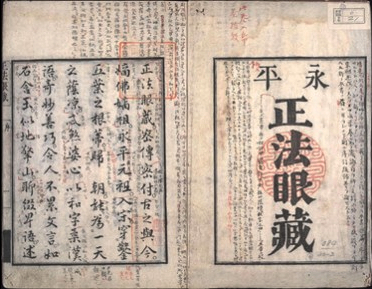Shōbōgenzō
In Japanese, “Treasury of the True Dharma Eye”; the magnum opus of the Japanese Zen master Dōgen Kigen (1200-1253); the title refers to the Zen (C. Chan) school, which is considered to be the repository of the insights of the buddha Śākyamuni himself, transmitted through the lineage of the Chan patriarchs (zushi) starting with Mahākāśyapa... Dōgen’s oeuvre contains two works with this title...The second is a collection of essays written in Japanese, known as the Kana [viz., “vernacular”] Shōbōgenzō, which is the better known of the two and which will be the focus of this account. The Shōbōgenzō is a collection of individual essays and treatises that Dogen composed throughout his eventful career.... Six different editions of the Shōbōgenzō are known to exist: the “original” volume edited by Dōgen in seventy-five rolls, the twelve-roll Yōkōji edition, the sixty-roll Eiheiji edition edited by Giun (1253-1333), the eighty-four roll edition edited by Bonsei (d. 1427) in 1419, the eighty-nine roll edition edited by Manzan Dōhaku (1636-1715) in 1684 at Daishōji, and the ninety-five roll edition edited by Kōzen (1627-1693) in 1690 at Eiheiji. The seventy-five roll edition is today the most widely consulted and cited. Many of the essays were originally sermons delivered by Dōgen, such that some are written by him and others were recorded by his disciples. (Source: Princeton Dictionary of Buddhism, 810-811.)
Relevance to Buddha-nature
The third book of the Shōbōgenzō presents Dōgen's views on busshō (buddha-nature).
Philosophical positions of this text
| Other Titles | ~ Kana Shōbōgenzō |
|---|
Property "PagesScholarship" (as page type) with input value "Dōgen on Buddha Nature; Shōbōgenzō Buddha-Nature: Part 1; Shōbōgenzō Buddha-Nature: Part 2; Shōbōgenzō Buddha-Nature: Part 3; The Buddha-Nature in Dōgen's Shōbōgenzō; The Heart of Dōgen's Shōbōgenzō; The Zen Master Dōgen’s Understanding of the Buddha-Nature in Light of the Historical Development of the Buddha-Nature Concept in India, China, and Japan" contains invalid characters or is incomplete and therefore can cause unexpected results during a query or annotation process.


